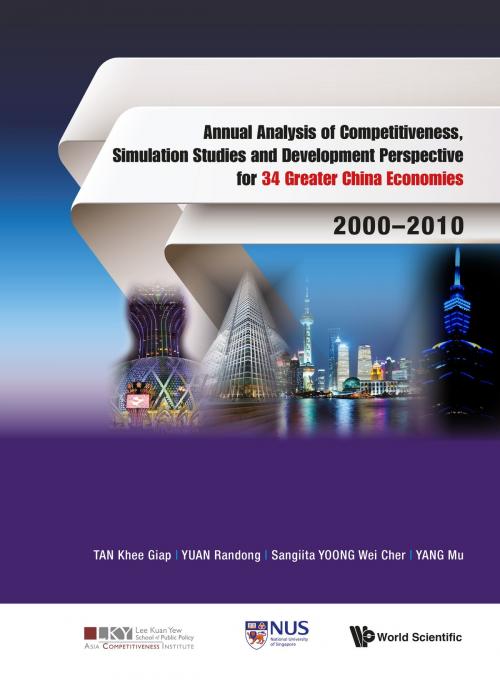Annual Analysis of Competitiveness, Simulation Studies and Development Perspective for 34 Greater China Economies: 20002010
Business & Finance, Economics, Economic Development| Author: | Khee Giap Tan, Randong Yuan, Sangiita Wei Cher Yoong;Mu Yang | ISBN: | 9789814579452 |
| Publisher: | World Scientific Publishing Company | Publication: | December 31, 2013 |
| Imprint: | WSPC | Language: | English |
| Author: | Khee Giap Tan, Randong Yuan, Sangiita Wei Cher Yoong;Mu Yang |
| ISBN: | 9789814579452 |
| Publisher: | World Scientific Publishing Company |
| Publication: | December 31, 2013 |
| Imprint: | WSPC |
| Language: | English |
China is emerging as one of the economic giants of the world, and is gaining international influence and global leadership that commensurate with its rise. China's performance will have far-reaching consequences on whether the economic awakening of the country, which began more than three decades ago, can become a good model to be emulated by other developing economies.
This book is a collection of policy papers and data-sets for the 34 Greater China economies. With a comprehensive approach to competitiveness, the research by Asia Competitiveness Institute (ACI) at Lee Kuan Yew School of Public Policy, National University of Singapore, takes into account different factors that collectively shape the ability of a nation to achieve substantial and inclusive economic development over a sustained period of time.
ACI's methodology goes beyond rankings as it conducts policy simulations on how each economy can improve its competitiveness. These policy simulations are a compelling value-added proposition as they enable policymakers, industry leaders and administrators to identify relative challenges and opportunities, and to prioritise areas in crafting public policies and development strategies.
Contents:
-
Annual Analysis of Competitiveness, Simulation Studies and Development Perspective for 34 Greater China Economies: An Overview
-
Anhui (安徽)
-
Beijing (北京)
-
Chongqing (重庆)
-
Fujian (福建)
-
Gansu (甘肃)
-
Guangdong (广东)
-
Guangxi (广西)
-
Guizhou (贵州)
-
Hainan (海南)
-
Hebei (河北)
-
Heilongjiang (黑龙江)
-
Henan (河南)
-
Hong Kong (香港)
-
Hubei (湖北)
-
Hunan (湖南)
-
Inner Mongolia (南蒙古)
-
Jiangsu (江苏)
-
Jiangxi (江西)
-
Jilin (吉林)
-
Liaoning (辽宁)
-
Macau (澳门)
-
Ningxia (宁夏)
-
Qinghai (青海)
-
Shaanxi (陕西)
-
Shandong (山东)
-
Shanghai (上海)
-
Shanxi (山西)
-
Sichuan (四川)
-
Taiwan (台湾)
-
Tianjin (天津)
-
Tibet (西藏)
-
Xinjiang (新疆)
-
Yunnan (云南)
-
Zhejiang (浙江)
-
Appendices:
- List of Indicators
- Computation of Rankings: The Algorithm
Readership: Professionals; researchers; think-tanks; policy makers; government officials.
Key Features:
- First unique volume with no other rival publications as yet, covering whole spread of all 34 economies
- China and rest of world will heed results by Asia Competitiveness Institute
- Asia Competitiveness Institute has published similar books on 33 Indonesian provinces, ASEAN-10 economies, and is also publishing another on 35 states and federal territories of India by similar regional insights
- This English version will also have an accompanying Chinese version
China is emerging as one of the economic giants of the world, and is gaining international influence and global leadership that commensurate with its rise. China's performance will have far-reaching consequences on whether the economic awakening of the country, which began more than three decades ago, can become a good model to be emulated by other developing economies.
This book is a collection of policy papers and data-sets for the 34 Greater China economies. With a comprehensive approach to competitiveness, the research by Asia Competitiveness Institute (ACI) at Lee Kuan Yew School of Public Policy, National University of Singapore, takes into account different factors that collectively shape the ability of a nation to achieve substantial and inclusive economic development over a sustained period of time.
ACI's methodology goes beyond rankings as it conducts policy simulations on how each economy can improve its competitiveness. These policy simulations are a compelling value-added proposition as they enable policymakers, industry leaders and administrators to identify relative challenges and opportunities, and to prioritise areas in crafting public policies and development strategies.
Contents:
-
Annual Analysis of Competitiveness, Simulation Studies and Development Perspective for 34 Greater China Economies: An Overview
-
Anhui (安徽)
-
Beijing (北京)
-
Chongqing (重庆)
-
Fujian (福建)
-
Gansu (甘肃)
-
Guangdong (广东)
-
Guangxi (广西)
-
Guizhou (贵州)
-
Hainan (海南)
-
Hebei (河北)
-
Heilongjiang (黑龙江)
-
Henan (河南)
-
Hong Kong (香港)
-
Hubei (湖北)
-
Hunan (湖南)
-
Inner Mongolia (南蒙古)
-
Jiangsu (江苏)
-
Jiangxi (江西)
-
Jilin (吉林)
-
Liaoning (辽宁)
-
Macau (澳门)
-
Ningxia (宁夏)
-
Qinghai (青海)
-
Shaanxi (陕西)
-
Shandong (山东)
-
Shanghai (上海)
-
Shanxi (山西)
-
Sichuan (四川)
-
Taiwan (台湾)
-
Tianjin (天津)
-
Tibet (西藏)
-
Xinjiang (新疆)
-
Yunnan (云南)
-
Zhejiang (浙江)
-
Appendices:
- List of Indicators
- Computation of Rankings: The Algorithm
Readership: Professionals; researchers; think-tanks; policy makers; government officials.
Key Features:
- First unique volume with no other rival publications as yet, covering whole spread of all 34 economies
- China and rest of world will heed results by Asia Competitiveness Institute
- Asia Competitiveness Institute has published similar books on 33 Indonesian provinces, ASEAN-10 economies, and is also publishing another on 35 states and federal territories of India by similar regional insights
- This English version will also have an accompanying Chinese version















